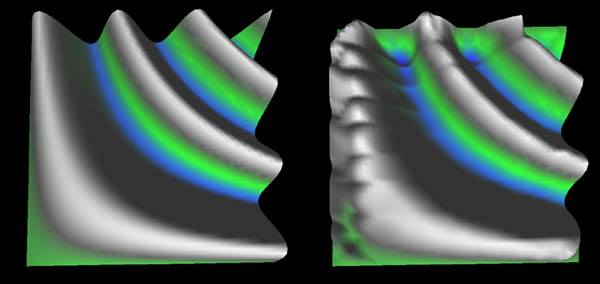Main
Start of topic | Skip to actions
I finished an implementation of the simplex spline approximation presented in
Neamtu's latest paper. Below is a screen shot. On the left is the target function
to approximate (sin(x*y)) and the on the right is the approximation with simplex spline
basis from a 10X10 grid knot sets. ( The normal of the simplex spline is computed
with a formula found in an old paper by Holliag. )
 There are some questions that Neamtu's paper leaves unanswered about the basis functions used.
Each basis function he uses for interpolation is the sum of simplex spline basis from
Delaunay configurations that have identical interior knots. What's the property of the basis? In particular,
There are some questions that Neamtu's paper leaves unanswered about the basis functions used.
Each basis function he uses for interpolation is the sum of simplex spline basis from
Delaunay configurations that have identical interior knots. What's the property of the basis? In particular,
to top
 There are some questions that Neamtu's paper leaves unanswered about the basis functions used.
Each basis function he uses for interpolation is the sum of simplex spline basis from
Delaunay configurations that have identical interior knots. What's the property of the basis? In particular,
There are some questions that Neamtu's paper leaves unanswered about the basis functions used.
Each basis function he uses for interpolation is the sum of simplex spline basis from
Delaunay configurations that have identical interior knots. What's the property of the basis? In particular,
- The support of each basis is the union of a set of convex hulls, which I checked can be non-convex. Does it even have a a unique local maximum? (seems that way by eyeballing) I want to check this. Question: where is a good mathematical treatment for B-spline. Most references are too graphicy...
- How good is the choice of Greville site? (averaging of interior points). In other words, how far is it from the basis maximum?
- How many basis are there given n knots?
- a simple spline surface is a piecewise polynomial. Can we say anything about the "pieces" that this particualr choice of basis gives us?
- Hans-Peter Seidel has a paper (1991) on simplex spline basis that are constructed over triangulation.
- natural neighbor interpolation.
- Bezier-based approach
to top
| I | Attachment  | Action | Size | Date | Who | Comment  |
|---|---|---|---|---|---|---|
| | sspline.jpg | manage | 24.7 K | 10 Mar 2005 - 03:08 | YuanxinLiu |
Edit | Attach image or document | Printable version | Raw text | More topic actions
Revisions: | r1.2 | > | r1.1 | Total page history | Backlinks
Revisions: | r1.2 | > | r1.1 | Total page history | Backlinks